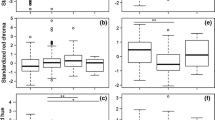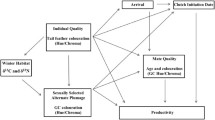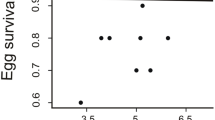Abstract
Carotenoid-based colouration plays an important role in sexual signaling in animals as an honest indicator of individual quality during mate choice and competitive interactions. However, few studies have examined how natural variation in weather conditions influences inter-annual variation in the expression of ornamentation, potentially through affecting the dietary availability of carotenoids. In this study, we examine variation in the expression of carotenoid-based plumage colouration in relation to temperature and rainfall during the pre-moulting and moulting period over 11 years in a population of American redstarts, Setophaga ruticilla, breeding in eastern Canada. We used reflectance spectrometry of tail feathers collected from male and female redstarts to relate feather colour with weather conditions the previous breeding season during the months over which redstarts are likely to moult (June–September). At a population level, birds expressed feathers with higher red chroma and lower brightness in years following high July rainfall and low August temperature. The pattern was stronger in males, but was generally consistent across ages and sexes. Analyses of feathers from repeatedly captured birds indicated that the above patterns could be explained by individual change in feather colour. We suggest that higher rainfall during the moulting period may increase insect abundance and the availability of dietary carotenoids. This is among the first studies to show effects of weather conditions on a sexual signalling trait, which may have important consequences for sexual selection, mate choice, and the reliability of putative signals.






Similar content being viewed by others
References
Angelier F, Tonra CM, Holberton RL, Marra PP (2011) Short-term changes in body condition in relation to habitat and rainfall abundance in American redstarts Setophaga ruticilla during the non-breeding season. J Avian Biol 42:335–341
Armenta JK, Dunn PO, Whittingham LA (2008) Effects of specimen age on plumage color. Auk 125:803–808
Boomsma JJ, Leusink JA (1981) Weather conditions during nuptial flights of four European ant species. Oecologia 50:236–241
Burnham KP, Anderson DR (2002) Model selection and multimodel inference: a practical information-theoretic approach, 2nd edn. Springer, New York
Cockburn A, Osmond HL, Double MC (2008) Swingin’ in the rain: condition dependence and sexual selection in a capricious world. Proc R Soc Lond B 275:605–612
Collister DM, Wilson S (2007) Contributions of weather and predation to reduced breeding success in a threatened northern Loggerhead Shrike population. Avian Ecol Evol 2:11
Cotton S, Fowler K, Pomiankowski A (2004) Do sexual ornaments demonstrate heightened condition-dependent expression as predicted by the handicap hypothesis? Proc R Soc Lond B 271:771–783
Doutrelant C, Gregoire A, Midamegbe A, Lambrechts M, Perret P (2012) Female plumage coloration is sensitive to the cost of reproduction: an experiment in blue tits. J Anim Ecol 81:87–96
Dunn P (2004) Breeding dates and reproductive performance. Adv Ecol Res 35:69–87
Eeva T, Ryoma M, Riihimaki J (2005) Pollution-related changes in diets of two insectivorous passerines. Oecologia 145:629–639
Eeva T, Sillanpaa S, Salminen JP, Nikkinen L, Tuominen A, Toivonen E, Pihlaja K, Lehikoinen E (2008) Environmental pollution affects the plumage color of great tit nestlings through carotenoid availability. EcoHealth 5:328–337
Eeva T, Helle S, Salminen J-P, Hakkarainen H (2010) Carotenoid composition of invertebrates consumed by two insectivorous bird species. J Chem Ecol 36:608–613
Endler JA (1983) Natural and sexual selection on color patterns in poeciliid fishes. Environ Biol Fish 9:173–190
Galeotti P, Rubolini D, Sacchi R, Fasola M (2009) Global changes and animal phenotypic responses: melanin-based plumage redness of scops owls increased with temperature and rainfall during the last century. Biol Lett 5:532–534
Germain RR, Reudink MW, Marra PP, Ratcliffe LM (2010) Carotenoid-based male plumage predicts parental investment in the American Redstart. Wilson J Ornithol 122:318–325. doi:10.1676/09-107.1
Griggio M, Devigili A, Hoi H, Pilastro A (2009) Female ornamentation and directional male mate preference in the rock sparrow. Behav Ecol 20:1072–1078. doi:10.1093/beheco/arp099
Hill GE (1992) Proximate basis of variation in carotenoid pigmentation in male house finches. Auk 109:1–12
Hill GE (2000) Energetic constraints on expression of carotenoid-based plumage coloration in male House Finches. J Avian Biol 31:559–566
Hill GE (2006) Female mate choice for ornamental coloration. In: McGraw KJ (ed) Bird coloration. Function and evolution, vol 2. Harvard University Press, Cambridge
Hill GE, McGraw KJ (eds) (2006) Bird coloration. Function and evolution, vol 2. Harvard University Press, Cambridge
Hill GE, Montgomerie R (1994) Plumage colour signals nutritional condition in the house finch. Proc R Soc Lond B 258:47–52
Ilyina TA, Kerimov AB, Zagubizhenko MV, Maksimov GV (2013) Seasonal dynamics of leaf-eating insects biomass and its influence on carotenoid content in feathers of great tit nestlings. Russ J Ecol 44:507–514
Lozano GA (1994) Carotenoids, parasites, and sexual selection. Oikos 70:309–311
McKellar AE, Marra PP, Hannon SJ, Studds CE, Ratcliffe LM (2013) Winter rainfall predicts phenology in widely separated populations of a migrant songbird. Oecologia 172:595–605
Montgomerie R (2008) CLR, version 1.05 [Internet]. Kingston (ON): Queen’s University. http://post.queensu.ca/~mont/color/analyze.html. Accessed 10 Feb 2013
Morrison SA, Bolger DT (2002) Lack of an urban edge effect on reproduction in a fragmentation-sensitive species. Ecol Appl 12:398–411
Moser JC (1967) Mating activities of Atta texana (Hymenoptera: formicidae). Insect Soc 14:295–296
Newton I (1998) Population limitation in birds. Academic, London
Newton I, Dawson A (2011) Seasonal changes in moult, body mass and reproductive condition in siskin Carduelis spinus exposed to daylength regimes simulating different latitudes. J Avian Biol 42:22–28
Norris DR, Marra PP, Kyser TK, Ratcliffe LM, Montgomerie R (2007) Continent-wide variation in feather colour of a migratory songbird in relation to body condition and moulting locality. Biol Lett 22:16–19
Osmond MM, Reudink MW, Germain RR, Nocera JJ, Boag PT, Ratcliffe LM (2013) Relationships between carotenoid-based female plumage and age, reproduction and mate color in the American redstart (Setophaga ruticilla). Can J Zool 91:589–595
Partali V, Liaaen-Jensen S, Slagsvold T, Lifjeld JT (1987) Carotenoids in food-chain studies II. The food-chain of Parus spp. monitored by carotenoid analysis. Comp Biochem Physiol B Comp Biochem 87:885–888
Pyle P (1997) Identification guide to North American birds, part 1. Slate Creek, Bolinas
Qvarnstrom A (1999) Genotype-by-environment interactions in the determination of the size of a secondary sexual character in the collared flycatcher (Ficedula albicollis). Evolution 53:1564–1572
R Core Team (2013) R: a language and environment for statistical computing. R Foundation for Statistical Computing, Vienna. http://www.R-project.org/
Reudink MW, Marra PP, Langin KM, Studds CE, Kyser TK, Ratcliffe LM (2008) Molt-migration in the American Redstart (Setophaga ruticilla) revisited: explaining variation in feather δD signatures. Auk 125:744–748
Reudink MW, Marra PP, Boag PT, Ratcliffe LM (2009a) Plumage coloration predicts paternity and polygyny in the American redstart. Anim Behav 77:495–501. doi:10.1016/j.anbehav.2008.11.005
Reudink MW, Studds CE, Kyser TK, Marra PP, Ratcliffe LM (2009b) Plumage brightness predicts non-breeding season territory quality in a long-distance migratory songbird, the American redstart Setophaga ruticilla. J Avian Biol 40:34–41
Robinson SK, Holmes RT (1982) Foraging behavior of forest birds: the relationship among search tactics, diet, and habitat structure. Ecology 63:1918–1931
Roulin A, Richner H, Ducrest A-L (1998) Genetic, environmental, and condition-dependent effects on female and male ornamentation in the barn swallow Tyto alba. Evolution 52:1451–1460
Roulin A, Gasparini J, Bize P, Ritschard M, Richner H (2008) Melanin-based colorations signal strategies to cope with poor and rich environments. Behav Ecol Sociobiol 62:507–519
Roulin A, Burri R, Antoniazza S (2011) Owl melanin-based plumage redness is more frequent near than away from the equator: implictions on the effect of climate change on biodiversity. Biol J Linn Soc 102:573–582
Saino N, Szep T, Ambrosini R, Romano M, Moller AP (2004) Ecological conditions during winter affect sexual selection and breeding in a migratory bird. Proc R Soc Lond B 271:681–686
Saks L, McGraw K, Hõrak P (2003) How feather colour reflects its carotenoid content. Funct Ecol 17:555–561. doi:10.1046/j.1365-2435.2003.00765.x
Santos ESA, Scheck D, Nakagawa S (2011) Dominance and plumage traits: meta-analysis and metaregression analysis. Anim Behav 82:3–19
Schielzeth H (2010) Simple means to improve the interpretability of regression coefficients. Methods Ecol Evol 1:103–113
Scordato ES, Bontrager AL, Price TD (2012) Cross-generational effects of climate change on expression of a sexually selected trait. Curr Biol 22:78–82
Sherry TW, Holmes RT (1997) American Redstart (Setophaga ruticulla). In: A Poole and F Gill (eds) The birds of North America. No. 277. The Academy of Natural Sciences, Philadelphia, and the American Ornithologists’ Union, Washington, DC
Siefferman L, Hill GE (2005) Male eastern bluebirds trade future ornamentation for current reproductive investment. Biol Lett 1:208–211
Slagsvold T, Lifjeld JT (1985) Variation in plumage colour of the Great tit Parus major in relation to habitat, season and food. J Zool 206:321–328
Studds CE, Marra PP (2007) Linking fluctuations in rainfall to nonbreeding season performance in a long-distance migratory bird, Setophaga ruticilla. Clim Res 35:115–122
Studds CE, Marra PP (2011) Rainfall-induced changes in food availability modify the spring departure programme of a migratory bird. Proc R Soc Lond B 278:3437–3443
Stutchbury BJM, Gow EA, Done T, MacPherson M, Fox JW, Afanasyev V (2011) Effects of post-breeding moult and energetic condition on timing of songbird migration into the tropics. Proc R Soc Lond B 278:131–137
Tonra CM, Marini KLD, Marra PP, Germain RR, Holberton RL, Reudink MW (2014) Color expression in experimentally regrown feathers of an overwintering migratory bird: implications for signaling and seasonal interactions. Ecol Evol 4:1222–1232. doi:10.1002/ece3.994
Tøttrup AP, Thorup K, Rainio K, Yosef R, Lehikoinen E, Rahbek C (2008) Avian migrants adjust migration in response to environmental conditions en route. Biol Lett 4:685–688
Wilson S, Arcese P (2004) El Nino drives timing of breeding but not population growth in the song sparrow (Melospiza melodia). Proc Natl Acad Sci USA 100:11139–11142
Wilson S, LaDeau SL, Tøttrup AP, Marra PP (2011) Range-wide effects of breeding- and nonbreeding-season climate on the abundance of a Neotropical migrant songbird. Ecology 92:1789–1798
Zuur AF, Ieno EN, Walker NJ, Saveliev AA, Smith GM (2009) Mixed effects models and extensions in ecology with R. Springer, New York
Acknowledgments
We thank would like to thank the many field assistants, technicians, and students that worked on this population over the years. We also thank the editor and two anonymous reviewers for helpful comments and suggestions. Funding for this project was provided by the National Science Foundation (P.P.M) and Natural Sciences and Engineering Research Council of Canada Discovery Grants to L.M.R. and M.W.R.
Author information
Authors and Affiliations
Corresponding author
Additional information
Communicated by Indrikis Krams.
M. W. Reudink and A. E. McKellar contributed equally to this work.
Rights and permissions
About this article
Cite this article
Reudink, M.W., McKellar, A.E., Marini, K.L.D. et al. Inter-annual variation in American redstart (Setophaga ruticilla) plumage colour is associated with rainfall and temperature during moult: an 11-year study. Oecologia 178, 161–173 (2015). https://doi.org/10.1007/s00442-014-3167-4
Received:
Accepted:
Published:
Issue Date:
DOI: https://doi.org/10.1007/s00442-014-3167-4




